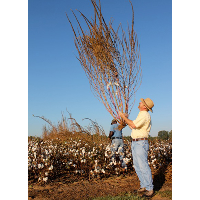Monsanto Chemical-Resistant Weed Strikes Southern Cotton Fields and Threatens Midwest
 Palmer amaranth in a cotton field (photo: Ohio State University Extension)
Palmer amaranth in a cotton field (photo: Ohio State University Extension)
In the 1970s, Monsanto introduced a new chemical to kill weeds. Known commonly as Roundup, it was capable of killing whatever weed got in its way. Seed companies later developed varieties of plants that were immune to Roundup’s killing power, enabling farmers to use one herbicide—Roundup—for all their crops.
Now, to put the problem in a nutshell: “You’ve heard of this guy called Chuck Darwin and evolution?” as Iowa State University agronomy professor Mike Owen put it to The Des Moines Register.
The herbicide, also known as glyphosate, became so ubiquitous in American agriculture that eventually Mother Nature started producing new weeds—16 so far—immune to the chemical. There are now enough glyphosate-resistant weeds in America to nearly cover the state of Oregon, Michael Wines reported at The New York Times.
Take the weed Palmer amaranth. It started showing up in cotton fields in the South, and before farmers knew it, it was everywhere. It can grow higher than six feet tall and spread a million seeds from each plant. Roundup was useless against it, leaving farmers the choice of pulling the weed by hand or using more powerful herbicides that could kill crops as well.
Now, it’s showing up in the Midwest.
“[Palmer amaranth’s] oval leaves and spindly seed heads blanket roadsides and jut above orderly soybean rows like skyscrapers poking through cloud banks,” Wines wrote. “It shrugs off extreme drought and heat. At up to six inches in diameter, its stalk is thick enough to damage farm equipment.”
Some of the blame for the spread of Roundup-resistant weeds goes to farmers, who have ignored traditional methods of crop diversification. “Even though we warned them, you understand the economics behind it,” Robert Hartzler, another ISU professor of agronomy, told The Register.
Some farmers are now growing different crops and making sure their tractors and combines are free of Palmer amaranth debris and seeds before moving them from one field to another.
-Noel Brinkerhoff, Steve Straehley
To Learn More:
Invader Batters Rural America, Shrugging Off Herbicides (by Michael Wines, New York Times)
On Front Lines, Farmers Struggle Against Chemical-Resistant Weeds (by Amy Mayer, Harvest Public Media)
Resistant Palmer Amaranth Spreading Rapidly in Kansas (by Dallas Peterson and Curtis Thompson, Farm Talk Newspaper)
'Superweeds' Choke Farms (by Donnelle Eller, Des Moines Register)
Pesticide Companies Use Clever Loophole to Avoid Regulation of Genetically Modified Grass(by Noel Brinkerhoff, AllGov)
EPA Approves Rise in Glyphosate Residue for Monsanto’s Herbicide (by Noel Brinkerhoff, AllGov)
- Top Stories
- Unusual News
- Where is the Money Going?
- Controversies
- U.S. and the World
- Appointments and Resignations
- Latest News
- Trump to Stop Deportations If…
- Trump Denounces World Series
- What If China Invaded the United States?
- Donald Trump Has a Mental Health Problem and It Has a Name
- Trump Goes on Renaming Frenzy






Comments